 |
|
|

|
2007
June
29-30
|
End-of-month miscellany
Not having done this month's quota of consulting work yet, I need to spend the weekend
programming, so I'll close out the month now with a few short notes.
Here is a Pascal compiler for AVR that seems to be
my kind of programming language for a microcontroller.
They've
extended Pascal with a "define" statement
for telling the compiler about the hardware.
I'm going to try it out.
And
this is the best
use for an analog oscilloscope I've seen in a while.
And here,
with extensive samples on line, is a good book about the
history of electronics.
See you in July!
Permanent link to this entry


|

|
2007
June
28
|
What is a programming language for?
Continuing yesterday's rant for a moment, I should explain that the context was microcontrollers,
and a discussion of BASCOM versus C.
There are those who maintain that C is all we will ever need.
In the discussion, I was taken aback by someone saying that in BASCOM, you focus on the task
rather than the machine instructions, and that's supposed to be a disadvantage.
It seems to me that focusing on the task rather than the machine is exactly what
programming languages are for. The selling point of Fortran back in '58 was that you
didn't have to think about machine instructions any more — you could think
about the mathematical problem you were trying to solve.
Unfortunately, C is so low-level that people have gotten accustomed to using it as an assembler.
Certainly, C requires you to do a lot of machine-level thinking.
For example, an array is the same thing as a pointer. And that's wrong.
In a properly designed programming language, an array is a space for a sequence of values,
and you shouldn't have to think about how the machine accesses it.
I don't object to tools that make our work easier.
That's what tools are for.
Permanent link to this entry


|

|
2007
June
27
|
Short notes
Is our weather getting warmer, or
just the weather stations?
It has transpired that a substantial number of American weather stations are no
longer out in the open, as they are meant to be.
Pavement and machinery have grown up around them.
Here
is a fine collection of BASCOM source code for AVR microcontroller —
in German.
Were computers perfect 25 years ago?
I could rant about this for a long time.
If you say UNIX is a good operating system and C is a useful programming
language, I agree with you.
But if you say that they are perfect, and no further progress should be permitted,
you're dead wrong. Yet a remarkable number of people seem to hold that belief.
It is sad when computer science students and young professionals won't use an OS or language
invented within their own lifetime.
Permanent link to this entry


|

|
2007
June
26
|
Published
 A major research publication from my lab has just come out:
A major research publication from my lab has just come out:
Michael A. Covington, Wim J. Riedel, Cati Brown,
Congzhou He, Eric Morris, Sara Weinstein, and James Semple,
"Does ketamine mimic the effect of schizophrenia on speech?"
Journal of Psychopharmacology,
Vol. 21, No. 3, 338-346 (2007).
What's it about? Well, there's a drug called ketamine that is used as a
veterinary anesthetic. In small doses, in humans, it is thought to produce
symptoms of schizophrenia (temporarily of course!).
If that's true, it's useful knowledge, because we know in some detail
how ketamine works, and maybe, to cure schizophrenia, all we need is a drug
that does the opposite.
So we analyzed data from a ketamine experiment that had been done in Cambridge, England,
and from a study of schizophrenia patients in Vancouver.
Our result? Ketamine doesn't mimic schizophrenia. It produces impairments,
all right, but not exactly the same impairments.
I want to thank all my colleagues and students whose hard work contributed
to this project. It took a long time.
It's not often that one gets to use computational linguistics to advance
medical science.
Permanent link to this entry
Brain of an Olympus OM-PC
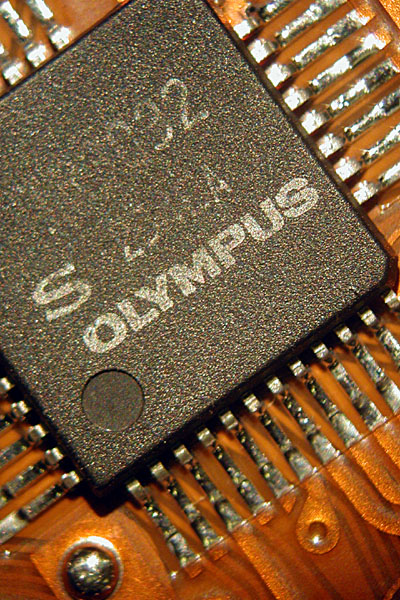
Some of you may recall that my trusty old Olympus OM-1 is due for a prism transplant.
(It will apparently get a new prism for its 31st birthday or thereabouts.)
A while back I acquired a junked OM-PC to be an organ donor.
On Sunday evening I got the prism out of the OM-PC.
The operation was rather gruesome because I knew I wouldn't have to put the OM-PC
together again; it was already electrically and mechanically kaputt.
So wires were clipped, paper-thin
printed-circuit boards were cut with scissors, several parts were bent
and scratched, and some worn-out external plastic parts went into the trash can.
But at the end I had a pristine prism, together with a couple of dozen tiny screws
and a few useful Olympus replacement parts, such as a door latch spring.
(Olympus tinkerers will know that the door latch spring has a tendency to fly
across the room and get lost when you remove the top cover.)
I salvaged, as a souvenir, a postage-stamp-sized piece of printed
circuit board containing the CPU (which may or may not actually be a microprocessor;
Olympus didn't say). That's what you see in the picture above.
Bausch & Lomb Stereozoom 4 with objectives set to 0.7x,
Bausch & Lomb 10x eyepiece (better than the eyepieces I used earlier),
and Nikon Coolpix 990 zoomed to telephoto.
The picture covers an area about 10 x 15 mm.
Permanent link to this entry
Books I read as a child
Given that title, you're probably expecting me to talk about Tom Sawyer
or Treasure Island (the latter of which I haven't actually read).
But I actually want to point you to a remarkable collection of PDFs of old
electronics books:
http://www.pmillett.com/technical_books_online.htm.
Several of these were on my shelf, or the local public library's shelf, when I was
in elementary school.
In particular, if you can do an 8-megabyte download, look at
Television and Radio Repairing,
by John Markus (1953).
This was already rather dated by the time I read it (about 1965), but thanks to the author's good
sense of what to include and what to leave out, it remained quite useful.
That's partly because it's a very basic book about tools and techniques.
Much of what's in it is still useful today.
Incidentally, I do read real literature, not just technical and scientific books.
Remember, I had a classical literary education and can quote Catullus from memory.
O dulces comitum valete coetûs...
And there's a connection. One of my favorite poems is Gerard Manley Hopkins'
Pied Beauty.
Experts agree that this is a great poem.
But note what it's about.
Basically, it's about intricate and variegated structure:
Glory be to God for dappled things —
for skies of couple-colour as a brinded cow,
for rose-moles all in stipple upon trout that swim
...
and all trades, their gear and tackle and trim.
...
That is: Praise God for not making things uniform and simple.
Speckles and structures within structures are fascinating.
If only Hopkins had known about the mathematics of fractals...
And note that among "dappled things"
he included technology ("all trades, their gear...").
Technology is one of the most human of human activities.
One critic said Pied Beauty was about the Industrial Revolution.
Hmmm. Speckled cows are not products of industry.
Maybe the critic was merely upset that the poem
wasn't anti-Industrial Revolution the way poems are supposed to be.
Hopkins was onto something.
This is the only poem about its particular subject that I've ever seen.
For a Hopkins poem about a much more familiar subject,
which nonetheless will send a chill down your spine, see
Spring and Fall.
Like all of Hopkins, this one is slightly hard to read at first, but
once you've grasped his rather complex, densely-packed wording, you'll
find that it sticks with you even though you didn't set out to memorize it.
Permanent link to this entry


|

|
2007
June
25
|
BAT files to switch between Windows XP and Vista
Like a lot of people right now, I dual-boot Windows XP and Vista from different partitions
on the same computer. Each operating system can see both partitions. XP runs from C:,
Vista from D:.
The usual way to switch operating systems is to restart the machine and wait for the boot menu
to come up, then make a choice. If you aren't sitting at the keyboard when the menu comes up
and times out, you get whichever OS is selected as the default.
Well... I wanted something like the old
BOOT /DOS and
BOOT /OS2 commands under OS/2.
That is, I wanted to be able to
launch a reboot into the other OS
without having to stay around and wait for the boot menu.
Here's my quick-and-dirty solution.
(1) Make sure the SYSTEM32 folder of each of the two systems contains its own version
of shutdown.exe. Normally, they do.
(2) Find the file bcdedit.exe in the SYSTEM32 folder of Vista, and copy it into
the SYSTEM32 folder of XP. It's the boot sequence editor.
(3) It doesn't matter at this point which OS you happen to be running.
Go to a command prompt and type: bcdedit
You'll get a list of operating systems and identifiers.
The identifier of XP is usually {ntldr} and the name may be
"Legacy OS" or words to that effect.
The identifier of Vista is something like
{c0801dbd-f54e-11db-ae71-8a77aa85b350},
but don't copy this — look and see what it is on your own computer.
(4) On your Windows XP desktop, create a file called BOOT-VISTA.BAT
containing the following:
bcdedit /default {c0801dbc-f54e-11db-ae71-8a77aa85b350}
shutdown -r -t 10
Use the actual identifier for Vista on your machine, of course, not the gibberish from mine.
Double-click this file whenever you want to switch to Vista.
(5) On your Vista desktop, create a file called BOOT-XP.BAT containing
the following:
bcdedit /default {ntldr}
pause
shutdown -r -t 10
Why the pause command? Because BOOT-XP.BAT only works if you right-click it and choose
Run As Administrator. Vista won't let you make changes to the boot sequence
without that step, even if you're
using an administrator account. The pause allows you to see whether the BCDEDIT command worked.
I know a much more elegant solution is possible, but this is already
enough to save me lots of time.
Permanent link to this entry


|

|
2007
June
24
|
Miscellany
Soloway, the Spam King, has been
denied bail
(at his second hearing)
on the sensible ground that he's never followed
anybody's orders before now, so why should he stay
in town (or even the United States) just because
he's out on bail?
He'll be in jail until his trial, scheduled for August 6.
If you enjoy reading the comic page of the newspaper,
check out
The Houston Chronicle's online version.
You can "build your own comics page" (a complex URL) and save it as a bookmark.
No registration is required.
The other day I said that there should not be legislation against "price gouging."
Here's why,
explained lucidly by a Harvard economist.
Owners of gas stations shouldn't have to spend their time wondering whether a price
increase is "unconscionable." Anyhow, having no fuel is worse than having
high-priced fuel, and those are the only alternatives.
You can't make things cheap and abundant by just controlling the price.
Optical instrument of the day:
Leeuwenhoek lives!
Or at least, someone is still making single-lens microscopes, and they work.
Permanent link to this entry


|

|
2007
June
23
|
Microcontrollers made ridiculously easy
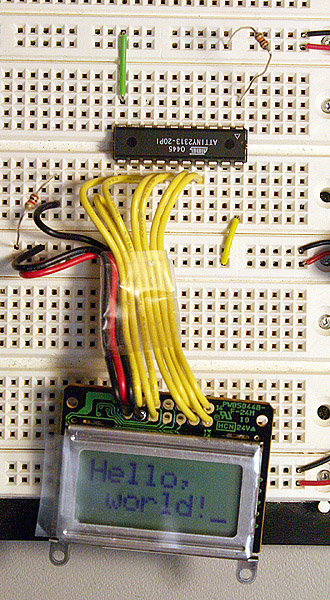 I've already chronicled a few of my
adventures with Atmel AVR microcontrollers.
But the other day I started seriously using a tool that exemplifies what I think is
the right approach to microcontrollers.
I've already chronicled a few of my
adventures with Atmel AVR microcontrollers.
But the other day I started seriously using a tool that exemplifies what I think is
the right approach to microcontrollers.
Not a C compiler, which merely lets me paraphrase my assembly-language code into structured format.
Not a runtime system like the BASIC Stamp, which requires a specially programmed, expensive microcontroller.
What I'm using is
BASCOM,
a BASIC compiler that allows me to express
common microcontroller operations concisely, even if they are complex.
BASCOM is little used in the United States, but it has a loyal following
in Germany.
BASIC is in some ways an ugly programming language.
But it has one redeeming virtue: Its set of statements is open-ended, and that allows
implementors to make common operations easy.
At the right you see the circuitry to write "Hello, world!" on a standard LCD display
using an Atmel ATtiny2313. Below is the program. (For ease of display here, it contains
some line breaks that aren't permitted in real BASCOM.)
$regfile = "attiny2313.dat"
$crystal = 1000000
Config Lcd=16*2
Config Lcdpin=Pin, Rs=Portb.0, E=Portb.1, Db4=Portb.2, Db5=Portb.3, Db6=Portb.4, Db7=Portb.5
Cls
Lcd "Hello,"
Lowerline
Lcd " world!"
End
Notice that BASCOM lets you decide for yourself which pins of the microcontroller
will go to which pins of the LCD. A C compiler could have done that with two
pages of #define directives, but BASIC, being an open-ended language, can do it in
one statement.
That's where special-purpose compilers such as BASCOM have the advantage over
standard languages. The compiler doesn't just translate elementary operations
from one notation to another, and call subroutines; it can handle code generation
for things such as LCD interfaces, sound, networking, and so forth, using statements
that combine declarative and imperative elements.
Permanent link to this entry


|

|
2007
June
22
|
Dots

Today's photomicrograph shows dots (1/150 inch apart) produced by a laser
printer rendering a light gray tone. As you know if you have a magnifying glass,
laser printers don't print gray — they just print dot patterns.
And as you can see here, each dot is composed of tiny specks of toner, which are
particles of plastic that adhere to the paper because they have been heated and
partly melted.
Bausch & Lomb Stereozoom 4 with 2x auxiliary lens, objective zoomed to 3x, 10x eyepiece,
and Nikon Coolpix 990.
Permanent link to this entry
Exerting a bit of political influence
I may have actually influenced Georgia politics just a bit.
Recall what I said a few days ago about not voting for
people who pester me with automatic, recorded phone calls.
I said the same thing in a letter to the local newspaper.
Recall also that the election was a 3-way split with the second and third
candidates differing by only a few votes.
This is a nonpartisan special election to represent the late Rep. Charlie Norwood.
At this point, we have both a Republican and a Democrat who are still waiting for the final
count to see who gets to be in the runoff.
My letter was published yesterday morning (June 21) along with a letter from someone else
saying the same thing.
And first thing in the morning I got a phone call from a very well-respected retired
Georgia legislator, still active in the Democratic Party, expressing strong support.
It's not often that they call me to express support!
In fact, this is the first time it's happened.
Permanent link to this entry
Miscellany
How to lose a house, if you're a bank:
Guess what? If you lend people more than their house is worth
(a zero-down-payment loan in a declining market), they may
choose to lose the house
and just stop making payments when times get hard.
Those subprime ARMs work two ways.
Not only can the buyer not afford them, neither than the lender.
Was the Delphic Oracle intoxicated by ethylene?
For some time the standard theory has been that the
Delphic Oracle —
the ancient Greek priestess whose strange pronouncements were taken as prophecy —
was put into a trance by fumes of ethylene gas
from deep within the earth.
Now
this theory has been questioned.
(There probably wasn't nearly enough ethylene; if there had been, the Greeks
would have had fires and explosions as well as trances.)
Further, the authors raise a philosophical point.
Part of the ground of their questioning is that
modern people are too gullible.
The ethylene theory is exactly the kind of thing that 21st-century archeologists
want to believe, so they've swallowed it without adequate confirmation.
Is this song about anything at all?
Melody recently got a CD of The Association,
a pleasant-sounding group that has been singing for 40 years
with several changes of personnel.
They were the first act at the 1967 Monterey Pop Festival,
which means they bridged, or at least occupied, the gap
between the Beach Boys and the hippies.
Many of their songs were very popular in the late 1960s,
including "Cherish," "Windy," and "Never My Love."
They also produced "Along Comes Mary," which was co-opted by marijuana advocates
even though I can't find anything in the song to indicate that the composers intended
it to be taken that way.
On their
"Essentials"
album,
the audio mastering of some of the early songs is not too good.
Maybe they didn't have enough microphones, or maybe the controls were set wrong.
You often can't hear the lead vocalist under the accompaniment, and there
seems to be a peak around 1000-2000 Hz. I'm tempted to rip them into Adobe Audition
and run a graphical equalizer.
But back to the songs. What is "Windy" about, exactly? We must have heard
it a thousand times, and I've always wondered.
Is it about a little girl, an attractive young woman, or the weather?
The lyrics are
here, and
actually, as far as I can tell, there's no deep explanation to be found.
As was common in the late 1960s, there's an element of free association
or shifting metaphors.
(Naturally, some would attribute this to drugs, but some people would
attribute all late-1960s culture to drugs.)
"Windy" was originally a love song composed by a woman and
addressed to a man with penetrating eyes; The Association changed Windy to a girl,
adding some connotations that didn't totally mesh with the original ones.
Someone claimed the song is about electronic surveillance ("peeking out from
under a stairway...to capture a moment") and that, I think, is loony.
One nice thing about "Windy" that I hadn't noticed:
As you can see in
this video, there is an instrumental
passage played on a soprano recorder, an instrument of which
I have always been rather fond.
Permanent link to this entry


|

|
2007
June
21
|
Photomicrography
You've probably been wondering how soon you'd see some microscope photographs here.
Here are two. Both were taken with a Nikon Coolpix coupled afocally to a Nikon HKW 10X eyepiece
using an LE-Adapter
(which, as far as I can tell, is no longer made).
Since the camera was zoomed into its telephoto range and the pictures were subsequently
cropped, you are seeing a considerably smaller field than the human eye would see with the same
microscope at the same power.
First, an old prepared slide of a sardine's scale:

Nikon S microscope at 40x using Nikon Plan 40X objective and Köhler transillumination.
Second, the Lincoln Memorial on the back of a 1-cent piece:

Bausch & Lomb Stereozoom 4, 0.7x objective, giving just 7x total power, with Nicholas illuminator.
This Nikon eyepiece is optically not correct for this microscope, so there is some color fringing.
Also, the Nicholas illuminator is not ideal for metal objects; it shows the granular structure
all too well, almost like illuminating the object with a laser.
(Of course, for inspecting metalwork, solder, and glue, that's desirable.)
What's important here is that the camera saw at least as much as I did, probably more,
using the microscope at the same power.
I'm interested in microscopes for the optics, not the biology, so you're not going to see
anything very biologically exciting here. For me, a microscope is another kind of telescope,
just smaller, and I want microscopic and astronomical technologies to cross-fertilize.
Toward this end I was delighted, today, to see one of my early astrophotography books
cited in the bibliography of
Photography
with a Microscope, by Rost and Oldfield.
But that was before digital cameras made everything so easy and rewarding.
One thing's for sure... with digital photomicrography this good, there's no longer as much
demand for permanent microscope slides. I learned long ago that they're hard to make.
Maybe the need is going away.
Permanent link to this entry
Is "repressed memory" a modern invention?
News from the world of brain science:
One of the best-known factoids in all of psychiatry is that people develop
amnesia for traumatic events.
Sometimes the "repressed memories" can be recovered in psychotherapy,
and then the patient realizes that she was abused as a child, or that he
experienced something horrible while in the Army.
Well... I'm not saying "repressed memory" doesn't happen, but there
have already been scandals about people "remembering" things that never happened.
And now look at this:
Pope, H.G.; Poliakoff, M.B.; Parker, M.P.; Boynes, M; and Hudson, J.I.
Is dissociative amnesia a culture-bound syndrome? Findings from a survey of historical literature.
Psychol. Med. 37(2):225-33.
The authors found no description of trauma-induced amnesia in any form of literature —
factual or fiction, anywhere in the world — earlier than Dickens' Tale of Two Cities (1859).
They found plenty of descriptions of amnesia caused by head injury, delirium (from severe injury
or illness of any kind), epilepsy, and psychosis, but none where an otherwise completely lucid
person suffered loss of memory occasioned by, and concealing, a traumatic event.
As I said, I'm not saying "repressed memory" doesn't happen, and neither are Pope et al.
But why did it start happening in the 1850s?
Presumably because people have heard of it and it is, in some sense, consciously available
to them as a thing to do.
It's rather like fainting or "swooning," which was common in Victorian times because it
was on people's minds; they thought it was the expected reaction, but now it's out of fashion.
Permanent link to this entry


|

|
2007
June
20
|
Short notes
My technological accomplishment yesterday was
tuning a quadrature encoder by ear.
The threshold voltages for the two photocells needed adjusting.
Since the human ear is very good at detecting missing cycles in a waveform,
I simply connected the outputs to Walkman headphones,
spun the shaft, and adjusted for a smooth whine in both ears.
Scientific instrument of the day:
the microscope of King George III,
who was an amateur scientist.
Grief for griefers: Another sign that the Internet is finally growing out of infancy.
There have long been a lot of "griefers," people who anonymously slander others (often very viciously), but
when the victims are at Yale Law School, they
know how to fight back.
And they will strike a blow against the notion that everybody has an
absolute right to be anonymous on the Internet.
The Internet is not a fantasy game — it's part of the real world.
How he lost my vote:
We had a special election today, and I was all set to vote for a particular candidate until
his campaign made two automatic, recorded phone calls to my house in as many days.
It's against the law for businesses to use automatic recorded calls for advertising.
But the politicians who made that law made themselves exempt from it.
So now it's a politeness test, and he failed.
[Update, June 20: The election was very close,
we still don't have a final count, but this candidate may actually have
lost by just 5 or 10 votes. If a handful of other voters were influenced by
the phone calls the same way I was, then...]
Permanent link to this entry


|

|
2007
June
19
|
I don't want to watch videos or listen to podcasts
We used to read web pages. Now we're supposed to watch TV (on YouTube)
and listen to podcasts.
So I'm looking for a polite way to say this...
I don't have time to watch videos or listen to audio presentations just
because somebody, somewhere, suggests it.
I prefer written communication.
Web pages are great.
Writing is a fine invention, and hypertext is a worthwhile add-on.
Video and audio lack the biggest advantage of written communication:
You can't skim them.
You have to sit there, passively, and watch the show, rather than actively
choosing, moment by moment, what to read and which links to follow.
There are admittedly some good things on YouTube. I've even linked to some.
And there are good podcasts. But, frankly, I don't want to spend the time to listen to someone
talking, when I could read 5 times as fast or skim 50 times as fast.
When watching a video or listening to an audio recording, I feel trapped.
I can't skim, I can't see what's coming, I can't skip forward or backward in any useful way.
So please understand that I'm not especially keen on watching or listening to every
amusing thing that anyone wants to recommend.
Permanent link to this entry


|

|
2007
June
18
|
A few more little things
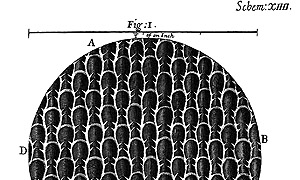 On the subject of microscopy, if you have time to read a short story, you'll enjoy
The Diamond Lens,
by Fitz-James O'Brien (1858), about a microscopist who has an adventure and goes mad...
probably the only extant short story revolving around the fact that the refractive
index of diamond is 2.4 (vs. 1.5 for glass, 1.0 for air).
On the subject of microscopy, if you have time to read a short story, you'll enjoy
The Diamond Lens,
by Fitz-James O'Brien (1858), about a microscopist who has an adventure and goes mad...
probably the only extant short story revolving around the fact that the refractive
index of diamond is 2.4 (vs. 1.5 for glass, 1.0 for air).
As that story makes clear, microscopes and telescopes aren't what they used to be.
In this era of electron microscopes and space probes, we think of any microscope or
telescope as a mid-scale instrument, for observing objects in a certain size range.
But 150 years ago a common microscope or telescope reached to the limits of human
knowledge, and everyone wished for more magnification (combined with better optics)
to see beyond the current limits.
Also, the organization
Micrographia has, on its main web page,
a movie of a ciliate protozoan (or maybe, rather, a rotifer)
that makes its own tiny whirlpool in order to
corral its food. It was originally photographed on Kodachrome movie film with
synchronized electronic flash. That was quite an achievement.
Speaking of Micrographia, Robert Hooke's famous 1665 book of that title is on line
at the National Library of Medicine
(as a Flash animation, so that you can
turn the pages yourself).
It's the world's first treatise on microscopy.
Unfortunately you cannot read it at that site except by using a clumsy moving
zoom window.
To actually read the book, go
here
or
here.
Finally, this
gentleman's 1904 photomicrography setup is obviously the precursor of one of my
own slide duplicators!
Permanent link to this entry


|

|
2007
June
17
|
Bausch & Lomb Stereozoom 4 microscope, vintage 1967?
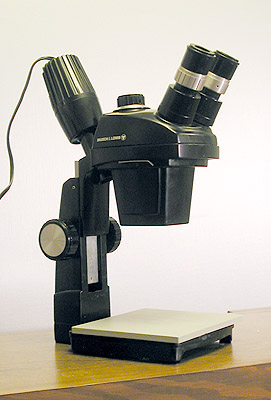
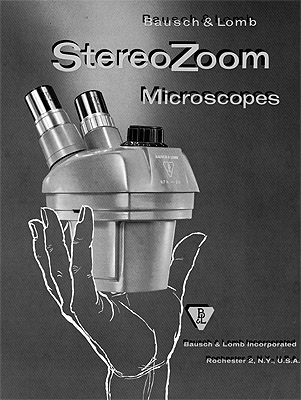
Here you see my new (old) microscope, which is rather battle-weary but was a great
bargain on eBay.
The stage plate was missing, so I made a gray wooden substitute.
Below, you see an example of why one wants a microscope
in an electronics workshop. The gadget I'm holding in my hand is a USB-interfaced
programmer for TI MSP430 microcontrollers. At some point I'm going to add some wiring
to it for an external socket. Obviously, I'll need a microscope. (Just like a biologist
doing a dissection, I can solder under this microscope with a fine-tipped iron.)
The microscope is very handy for
inspecting solder joints and even reading the low-contrast etched labels on ICs.
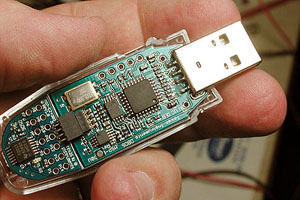
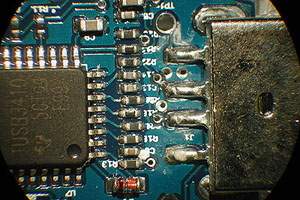
The last picture was taken by just holding the Nikon Coolpix 990 up to the eyepiece,
without any kind of adapter. All three of these pictures are below my usual standard,
but it's a busy week.
This is a Bausch & Lomb Stereozoom 4 microscope, a very popular model that was
later made by Leica, who bought out Bausch & Lomb's microscope product line.
It is truly stereoscopic; that is, there are two complete microscopes in it (not just
one microscope feeding two eyepieces), and you see in three dimensions.
(A sponge looks like a Martian landscape.) It magnifies 7x to 30x, which doesn't
sound like much but is ideal for this kind of work.
I already had the Nicholas illuminator, which shines a very well-collimated beam
of light onto the specimen (that is, the light rays are all traveling in parallel).
I may build something with LEDs that isn't quite so collimated, since it tends to cast
harsh shadows.
I already had to open up the Nicholas illuminator and clean dust off the lens nearest
the bulb, since dust specks there are projected into the beam of light.
This microscope needs non-compensating eyepieces, 23-mm tube diameter,
preferably the eyepieces that were originally
sold with it (Bausch & Lomb 31-15-61 10x wide-field);
the microscope and eyepieces seem to have been designed as a system.
When it reached me, it was equipped with a pair of
Olympus Bi WF10X,
which, despite not being labeled C or K, appear to be compensating eyepieces, meaning
they correct the lateral chromatic aberration of a conventional microscope.
(Indeed, they work fine with Nikon Planachromat objectives in another microscope.)
You can recognize a compensating eyepiece because the border of the field has an orange fringe.
If objects in the field, near the edge, also have orange fringes, then
compensating eyepieces aren't what you need.
And if you use a compensating eyepiece in a telescope,
the results can be truly amusing.
I've found a lot of Stereozoom 4 resources on the Web. Some of the high points:
(The last will take you to thousands of microscopy web pages.)
Also, I've done a bit of maintenance:
- Obviously, the collar around the left eyepiece is for making the two eyepieces focus
alike, or accommodating your unequal eyes if you need glasses and aren't wearing them.
- There's also a collar around the right eyepiece, but it's secured by a screw.
If you loosen the screw, you can adjust it to keep focus from varying as you zoom.
Go to high power, focus on something, zoom to low power, and see if it's still in focus.
If not, twist the collar to make up half of the error, then go back to high power,
focus the microscope again, and try again. Repeat until satisfied.
(For more about this see Xtronics.)
-
Although it's not for the fainthearted, I also lubricated the zoom mechanism.
Take the "pod" out of the stand, remove the lower cover, and you'll see a mechanism that
moves up and down on two rods. While taking great care not to touch any optical parts,
apply to each rod, with a toothpick, one or two drops of mineral spirits, followed
by a few strategic dabs of
Astrogrease,
turning the zoom knob back and forth repeatedly as you do so. This made the image stop
wiggling sideways as it zooms.
I hope to take some better pictures through this microscope and post them.
But I don't have time to become a serious
amateur microscopist...
...though I do have the equipment.
There's an equally antiquated, but beautifully refurbished, Nikon Model S in my
darkroom, and with it we've done a number of satisfying things.
Example: When Babbage the dog came down with an infestation of tiny mites,
we caught one on Scotch tape,
photographed it through the microscope,
and presented to the vet a picture showing
the mite enlarged to six inches long. The delighted veterinarian immediately pulled
out a book, showed us a very similar picture, and told us we'd found a rare kind of mite
which she would not have suspected without the photographic evidence.
In Victorian times,
every scientifically inclined person
had a microscope; it was a source of entertainment (instead of TV).
I prefer telescopes, at least for the most part.
[You may have to click or refresh that link more than once;
it's an AOL home page and apparently goes through a rather dodgy server at AOL.]
Permanent link to this entry


|

|
2007
June
16
|
A series of decreasing limericks
I'm still too busy to write anything original here, so today we'll have an item
from the standing collection: the series of decreasing limericks.
I don't remember where I got these, but they've amused Melody, Cathy, and Sharon
for years, and now it's your turn.
The first and longest:
There was a young lad from Japan
Whose limericks never would scan.
When he was asked why,
This was his reply,
I always try to get as many syllables into the last line as I possibly can.
You'd like something shorter? All right...
Another young lad from Japan
Wrote limericks that never would scan.
His verses would tend
To come to an end
Suddenly.
We can go further:
There was a bright girl at Purdue
Whose limericks would end at line 2.
And then:
There was a young girl from Verdun...
And where does this all end? With the zero-length limerick:
" "
This may be the kind of humor that only computer geeks can appreciate.
If it doesn't amuse you, don't worry; you may be sane.
Permanent link to this entry


|

|
2007
June
15
|
You may be hearing from the FBI...
I'm very busy and writing in great haste tonight, but here's a news update...
Both
the FBI
and
NATO
have finally realized that cyber-sabotage is real.
I tried to tell anyone who would listen, 14 years ago, but at that time,
everybody was sure these Internet squabbles were just disputes among
hobbyists.
According to the news releases,
you may be hearing from the FBI if your PC is a "spambot," one of the
virus-infected machines that transmit spam without their owners' knowledge.
That warrants an important warning:
Do not answer e-mail that claims to be from the FBI.
It's almost sure to be from an impostor.
If you get e-mail from the FBI that looks genuine, call a phone number that you know
is really the FBI (from the phone book), and verify it.
The FBI will never ask for computer passwords, credit card numbers, or bank accounts.
But plenty of people impersonating them will do so.
|
Incidentally, my personal opinion is that the pornography subculture on the Internet
is a great hindrance to the safety of the Net in two ways.
First, that's where people pick up viruses and spambots.
Owners of porn sites know you won't complain about them because you'd have to reveal what
you'd been looking at.
(Whether or not pornography is legal, people are ashamed of it,
and changing the law can't change that.)
Second, the porn subculture makes people demand too much privacy.
In my opinion, that's why we don't have very much authentication of network connections
(or even credit card charges!).
I'm in favor of privacy, but not to the extent of making it easy for people to
tamper with each other's computers or steal from me.
|
Permanent link to this entry
Technology at Covington Innovations
Very brief notes: I've had great success in my research lately, which you'll read about on
CASPR in due course. (Nothing new there today.)
I also spent an hour in the electronics lab reverse-engineering a
filar micrometer
(not the one shown here) with a long-forgotten digital interface;
more news about that when it's ready.
And I liked the
stereozoom microscope
at the lab so much that I bought one on eBay (cheap!) for my home workshop.
It needs a bit of fixing up but is optically perfect.
More news about that soon, too.
Let me congratulate the vendor,
CDN Systems,
for doing a remarkably fine job of packing it, basically building a structure
of foam blocks around it, without charging me much for shipping and handling.
Permanent link to this entry


|

|
2007
June
14
|
Very short notes
A very busy day. Briefly...
Weller Tools has
a blog about soldering irons
from which I've learned a number of interesting things.
The world's oldest company,
a Japanese builder of Buddhist temples founded in 578 A.D.,
has gone out of business.
Their mistake?
Investing borrowed money
(not in themselves, but in real estate).
As any expert will tell you, never invest borrowed money.
Have you seen the British TV series
The Secret Life of Machines?
If not, and if you have the time,
click the link and download the AVIs.
Highlights include a demonstration of how a tape recorder works — by
recording a snippet of audio onto
the moving blade of a bandsaw.
Permanent link to this entry


|

|
2007
June
13
|
Angle brackets prevent broken URLs in e-mail
One of the most enduring problems with e-mail — one that should have been
solved long ago — is that URLs (web addresses) get broken up by word wrap.
You may be trying to tell your friend to go to
http://www.somewhere.com/blah/blither/blatt.asp?parameter=value
but as likely as not, your friend will receive
http://www.somewhere.com/blah/blither/blatt.
asp?parameter=value
and click on the first part, which doesn't work.
I'm told this can often be circumvented by typing angle brackets around the URL
when you type your e-mail. That is, type:
<http://www.somewhere.com/blah/blither/blatt.asp?parameter=value>
and the address will arrive unscathed. Can my readers confirm this?
Does it have any official backing in the e-mail protocol specifications?
If so, why don't mail programs do it automatically?
Permanent link to this entry
Bird's eye views
I'm not sure if they invade people's privacy,
but the aerial photos
("bird's-eye views") on maps.live.com
certainly are interesting.
While cruising around the photos of
Cambridge, England,
I saw that a lot of buildings near the Crowne Plaza Hotel had been
torn down.
It turns out they're building
this.
What do they think they are, Atlanta?
I should add that my privacy concern — shared by many others — is mainly because the pictures
are distributed indiscriminately to the public. I'm not so worried about their use by the government,
mappers and surveyors, and so forth; that has been established to be legal.
But sure enough, the aerial or satellite imagers are already in trouble for having caught
a sunbather in an embarrassing situation
(don't worry, the picture is very blurry, but not quite blurry enough).
Permanent link to this entry


|

|
2007
June
12
(Extra)
|
How to time the execution of a C# program
I might as well put this in the Daily Notebook as anywhere else,
even though it results in an intercalary entry between
June 12 and June 13. So here goes.
First let me recommend the book
Data Structures
and Algorithms Using C#, by Michael McMillan
(Cambridge University Press, 2007).
This is the first C# book in a long time that has told me things I really
didn't know.
The book starts out with a technique for timing computations in C#, except
that I have a minor improvement to offer.
The technique is to use the ProcessThread.UserProcessTime property to find out how much
CPU time the computation has actually consumed. The operating system measures this for you,
to 1/64-second accuracy.
But I did it a bit differently than Mr. McMillan.
He always computed it on
Process.GetCurrentProcess().Threads[0], the lowest-numbered
execution thread belonging to the current program.
That works only if you're not running under Visual Studio.
Instead, I offer two approaches: get the UserProcessTime of the whole program,
or search for the active thread and use that. Most of the time, they give the
same result. Without further ado, here is a sample program,
which you can copy and paste into your editor:
using System;
using System.Collections.Generic;
using System.Text;
using System.Diagnostics; // for timing
namespace CsharpTiming
{
// Michael A. Covington 2007
// Very simple example of timing the execution of a method,
// based on McMillan, Data Structures and Algorithms in C#
// (Cambridge University Press, 2007).
// Note that the .NET 2.0 EULA specifies that if you publish
// timing results, you must specify how they were obtained.
// Microsoft is apparently worred that people will mistake
// JIT compilation or garbage collection for slow execution.
class Program
{
static int DoSomething()
{
// The computation to be timed. Silly example.
int j = 0;
for (int i = 1; i <= 10000; i++)
{
for (int k = 1; k <= i; k++) j++;
}
return j;
}
static void Main(string[] args)
{
TimeSpan start, duration;
int r;
//
// A simple way to do it...
//
// Do the timing
Console.WriteLine("Start...");
Process proc = Process.GetCurrentProcess();
start = proc.UserProcessorTime;
r = DoSomething(); // your computation
duration = proc.UserProcessorTime.Subtract(start);
// Report results
Console.WriteLine("Value computed: {0}", r);
Console.WriteLine("Time taken (s): {0}", duration.TotalSeconds);
//
// A better way to do it...
//
// Find the running thread
ProcessThread thread = null;
foreach (ProcessThread pt in Process.GetCurrentProcess().Threads)
{
if (pt.ThreadState == ThreadState.Running)
{
thread = pt;
break;
}
}
// Do the timing
start = thread.UserProcessorTime;
r = DoSomething(); // your computation
duration = thread.UserProcessorTime.Subtract(start);
// Report results
Console.WriteLine("Value computed: {0}", r);
Console.WriteLine("Time taken (s): {0}", duration.TotalSeconds);
// Wait for user to press Enter
Console.ReadLine();
}
}
}
|
And here is its output:
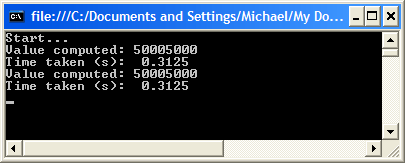
Because of limited resolutions, the timing values will differ haphazardly
by 1/64 second (0.015625 second).
Encapsulating the timer in an object, as McMillan did, is left as an exercise
for the student.
Permanent link to this entry


|

|
2007
June
12
|
Cubicles
It has long been known that computer programmers in private offices are
much more productive than computer programmers in cubicles.
This has been discussed in
The Embedded Muse
(Jack Ganssle's newsletter),
and in issue 146 (not on line yet), a correspondent suggests a twist to the story.
Maybe the cubicles are the effect, not the cause.
Maybe good programmers hate cubicles and bad programmers like cubicles.
The more your mind is on the work, the more you want to get away from distractions.
So maybe the best programmers make their bosses give them private space — or
simply change jobs until they get it — while bad programmers gravitate to
cubicle farms where they can gossip.
Permanent link to this entry
The Niederhofer plagiarism incident
If you have access to medical journals, look up the following two articles:
-
Niederhofer H, Staffen W, Mair A.
A placebo-controlled study of lofexidine in the treatment of children
with tic disorders and attention deficit hyperactivity disorder.
J Psychopharmacol. 2003 Mar;17(1):113-9.
-
Scahill L,
Chappell PB, Kim YS, Schultz RT, Katsovich L, Shepherd E, Arnsten AF, Cohen DJ, Leckman JF.
A placebo-controlled study of guanfacine in the treatment of children with tic disorders and attention deficit hyperactivity disorder.
Am J Psychiatry. 2001 Jul;158(7):1067-74.
(Click on them to see the abstracts in PubMed.)
The abstracts of the two papers begin as follows:
-
Niederhofer 2003:
This study evaluated the efficacy and safety of Lofexidine in treating children
with tic disorders and attention deficit hyperactivity disorder (ADHD). Subjects
from a specialty tic disorders clinic were randomly assigned to receive 8 weeks
of treatment with lofexidine or placebo under double-blind conditions. Follow-up
visits occurred every 2 weeks for safety monitoring and dose adjustment. Fourty-four
medication-free subjects (41 boys and three girls; mean age of 10.4 years) with ADHD,
combined type, and a tic disorder participated. After 8 weeks of treatment, lofexidine
was associated with a mean improvement of 41% in the total score on the teacher-rated
ADHD Rating Scale compared to 7% improvement for placebo...
-
Scahill 2001:
OBJECTIVE: This study evaluated the efficacy and safety of guanfacine in treating
children with tic disorders and attention deficit hyperactivity disorder (ADHD).
METHOD: Subjects from a specialty tic disorders clinic were randomly assigned to receive
8 weeks of treatment with guanfacine or placebo under double-blind conditions.
Follow-up visits occurred every 2 weeks for safety monitoring and dose adjustment.
RESULTS: Thirty-four medication-free subjects (31 boys and three girls with a mean
age of 10.4 years) with ADHD, combined type, and a tic disorder participated. After
8 weeks of treatment, guanfacine was associated with a mean improvement of 37% in
the total score on the teacher-rated ADHD Rating Scale, compared to 8% improvement
for placebo...
The same level of similarity continues through the whole papers, except the bibliographies,
which are substantially different. The papers even end with the same word.
What happened?
The editors of the Journal of Psychopharmacology never got a satisfactory answer,
so they "retracted" the Niederhofer paper. I agree with their assertion that they were
not negligent; reviewers judge the quality of research and do not look for plagiarism.
While the reviewers were probably aware of the Scahill paper, they probably didn't look
at them side by side and compare the wording. After all, the two papers are about different
drugs, and there's nothing wrong with doing simliar studies of rival drugs (in fact, it's a
good idea). Presumably, the identical wording was discovered when both papers got into
computer databases and someone used a search engine on them.
Permanent link to this entry
ADHD victims or just potheads?
A discussion is starting up in the
American Journal of Psychiatry
to the effect that
college students who seek help for attention deficit disorder should be given drug tests
since in many cases the reason they can't concentrate is marijuana.
That is a drug that lingers in the body for days after use — indeed, people have
told me that's why they like it — and of course it impairs intellectual function
the whole time. People who smoke pot every weekend are never completely sober.
That's a good reason for employers to give drug tests, too.
Permanent link to this entry


|

|
2007
June
11
|
A cluster and a ring
On the evening of June 9th we had unexpectedly clear weather
(it normally is cloudy here, at least by an astronomer's definition
of cloudy, from June through August).
Although I couldn't get out into the country or even do a long photo
session at home, I did get a couple of interesting pictures through
my 8-inch telescope with f/6.3 compressor, using the Digital Rebel XTi.
Each of these is a stack of four 3-minute exposures at ISO 400, minus
a stack of three dark frames.
Here's the magnificent globular cluster M4 in Scorpius:

And here is M57, the Ring Nebula in Lyra, photographed the same way, but
in this case you're looking at an enlargement of a small area of the picture.

The image processing of this one was a bit complex: dark frame subtraction,
stacking, and gamma correction with MaxIm DL followed by level adjustment
with Photoshop, grain removal with Neat Image, and detail enhancement
with RegiStax.
Permanent link to this entry
What to do with extra CPU power
Apple's latest user interface is
just a bit weird.
Animated smoke when you burn a CD?
And the smoke clears when you blow into your microphone?
It reminds me of 1950s teenage popular culture. "We don't have any good ideas,
but we've got to keep convincing ourselves that We're Fashionable and You're Not,
so we'll make up strange things at random and look down on people who don't
like them."
Or maybe the goal is to make it harder to write software so that the big
manufacturers will have less competition. "Never mind how well your spreadsheet runs,
you're passé.
You don't have an animated army of CPAs with pencils! Or even a talking paper clip!"
There are much better things to do with extra CPU power.
See Jeff Duntemann's comments.
It makes good sense to me to have the security of the system — booting,
virus-checking, and i/o — in the hands of one of the CPU cores while the rest
(with lesser privileges) run the applications.
A lot of this reminds me of 1970s mainframe architectures, such as the CDC 6400,
where the CPU does no i/o and the i/o processors run nothing but the OS.
We had extremely secure computers back when we didn't need them. Then the balance shifted
toward making computers versatile at any cost, partly because people thought of
early PCs as microprocessor breadboards rather than computing machines.
And that gave us a lot of good things, but also the virus problem.
Permanent link to this entry


|

|
2007
June
10
|
Aerial photography or invasion of privacy?
I looked up my house on Zillow the other day and
was surprised to see an aerial photograph,
credited to Microsoft Virual Earth,
that showed Cathy's fish pond, Babbage's doghouse, my telescope pier
(whose head is slightly smaller than a basketball), and numerous other fine
details. If there had been people outdoors, they might have been recognizable.
No, I'm not going to tell you where I live, but the way to get the image
is to click for information about the house and then ask for a bird's-eye view.
The aerial photo doesn't come up if you just zoom in or select "Aerial."
And it is definitely not a satellite image; the camera isn't looking straight down.
You can also get the same image on Microsoft's maps.live.com.
Now then...
Isn't it an invasion of privacy to photograph, from the air,
private property that is not visible from any public street, and
then give the pictures to anyone who wants them?
It's certainly very helpful to burglars who want to know where
the fences are!
Permanent link to this entry
A star of two kinds
In principle, there's no reason a star can't be both an eclipsing binary and a pulsating
variable, and now such a star has been discovered in our galaxy.
The AAVSO tells us
that the star TYC 1031 01262 1 is one.
It's a Cepheid with a period of about 4.5 days and also undergoes eclipses
(by an unseen companion star revolving around it) every 51.4 days.
The variations are of low amplitude (about 0.5 magnitude for the pulsations and 0.3 for the
eclipses), so they can only be observed with a photometer or photographic equipment.
The star is 11th magnitude.
In the sky, it appears very close to the variable star KU Herculis
and is about 5 degrees northeast of 72 Ophiuchi.
Permanent link to this entry
A familiar face is back

|
|
Regular readers will recall that, just over a year ago, my
Beckman Circuitmate DM25L digital multimeter
died a mysterious death.
I replaced it with two new meters, a BK 2704B and BK 2706A, and never
quite got accustomed to either one.
Well, recently on eBay I found a Beckman DM25XL in excellent condition.
This is just like the old DM25L but with a bigger, more readable display.
In fact, it is easily the most readable DMM I've ever used.
You could say, in view of my
recent misfortunes,
that it was literally
a sight for sore eyes.
I did bond well with the
Fluke 110 autoranging meter that I bought
for precision work.
It's easier to use and more accurate but has fewer functions.
And I'm keeping the
BK 2706A because it measures so very many things
(even temperature) but am selling the BK 2704B (want to make an offer?).
Three multimeters on one workbench are enough. There's one more
downstairs, of course,
plus a really cheap one in the drawer where we keep batteries
so they can be tested on the spot,
and another cheap one kept with my astronomy gear.
(Melody, are you reading this? At least I'm not accumulating cars, or horses...)
|
Permanent link to this entry


|

|
2007
June
9
|
Very short notes
Anyone who looked closely at me over the past several days might have seen occasional tears dripping
from my right eye. This is not a trick with brain hemispheres, nor a one-sided display of grief;
it's just a bacterial eye infection, which is now being treated. I was surprised at how it made me
feel run-down all over. That's one reason I haven't been writing much.
If you liked the steampunk keyboard, look at this
steampunk laptop,
apparently a real, working computer, through documented only in Japanese.
I'm not the only person who feels that
Microsoft's license terms for Vista are a mess.
In one situation over 40% of users thought they were licensed for something that they weren't.
I reported my own skirmish with the Vista license
last month.
Part of the problem is that the license is too complicated and comes in too many flavors.
The other is that because there is an online authentication procedure, people are going
to assume that the authenticator knows what it's doing, so if you pass authentication,
you're licensed. That is not always the case!
Incidentally, the
Vista bargains that I recommend
are genuine, but
some others are not.
Do not buy anything marked "NFR" ("Not For Resale").
You might think these are properly licensed disks left over from a manufacturing run
or from some sort of free distribution. They're not.
They're the installation disks for employees of companies that have
paid for a bulk license separately. By themselves, they're worthless.
Latest unconfirmed report from Sharon's laptop: Norton Internet Security can tie up
both cores on a dual-core CPU. If true, that is unkind, uncouth, and uncalled-for.
Permanent link to this entry


|

|
2007
June
8
|
Older Canon DSLRs not supported by Windows Vista
For a number of reasons — largely to plug security holes
and enforce 64-bit compatibility —
not all Windows XP device drivers run under Windows Vista.
Some hardware needs new drivers.
Sadly, some hardware still in wide use is not going to get new drivers.
Today I learned that Canon DSLRs prior to "DIGIC 2" are not going
to be supported. The EOS 10D and original Digital Rebel (300D) are not supported.
The 20D and 350D (XT) are OK, as are all the newer ones.
Don't panic. You can still process the pictures on your PC. You just can't
control the camera from your PC. I'm not sure if you can connect the camera to the
USB port and read it like a disk drive; you can certainly get the pictures into your
PC by plugging the memory card into a memory card reader. Astrophotographers
are going to be affected because they often control the camera through
a connection to a laptop computer.
Permanent link to this entry
A microscope for the workbench
Two days ago, the University of Georgia's Department of Microbiology contributed a dissecting
microscope for use in the AI electronics lab, which I manage.
We got a classic
Bausch & Lomb Stereozoom
which zooms from 7x to 30x and has a 4-inch working distance.
There's also a
Nicholas illuminator
which inserts into a hole in the microscope body, just behind the head, so that it shines
down on the specimen.
Why a microscope? Because we're starting to build surface-mount circuit boards with
tiny components, and the microscope is needed to inspect them.
In fact, I can solder under the microscope — it's a lot like a biologist doing a dissection.
A stereo zoom microscope is much handier than a handheld magnifier; you don't need a hand
to hold it! Instead, you walk up to it with whatever you're working on, put it on the stage,
and look in. The stage, by the way, is now covered with anti-static foam to protect sensitive
electronic components.
Yesterday I fixed the two Nicholas illuminators that they provided with it.
They just needed their bulb sockets cleaned and the bulbs reseated.
The design of
this gadget
hasn't changed in 40 years, and Leica and Bausch & Lomb make them exactly alike.
The illuminator contains a
6.5-volt 2.75-amp bulb
with a flange-skirted base like the headlamp of a 1930s automobile.
A bit of the light from the bulb is gathered by a lens and focused on the specimen.
The rest is wasted; they didn't even put a reflector behind it!
So I'm guessing I could build something with a cluster of white LEDs that would
throw as much light on the subject while consuming far less electricity.
I may do so.
Permanent link to this entry


|

|
2007
June
7
|
Short notes
I'm too busy to write anything today. Instead, you can read:
An interview with Niklaus Wirth,
inventor of Pascal and other
programming languages and techniques.
A video about what
tech support must have been like when the early
Christians invented the bound book.
(In Danish, or maybe Norwegian, with subtitles in Norwegian,
or maybe Danish, and also in English. Be sure to read the right line.)
Newspaper coverage of a doctor, accused of malpractice, who rather imprudently
anonymously
blogged his own trial and thereby disrupted it.
A PC keyboard
rebuilt in "steampunk" style (i.e., made to look as if it dates from the steam-engine era,
1880-1940 or so).
And
the third volume of Carl and Jerry
is out.
Permanent link to this entry


|

|
2007
June
6
|
Jon Hamlin
Word has reached me that my former student Jon Hamlin
has died
[link corrected, but not permanent]
at age 36 after a long illness.
Jon was the first (and, so far, the only) Valdostan to get a master's degree in artificial intelligence
from our program; he was an exceptionally good student; was recently employed as a computer
programmer for Bank of America in Jacksonville, Florida; and was a strong Christian.
He is unfortunately not the first of my students that I have outlived; a number of years
ago Michael Kelley passed away from a heart disorder while in graduate school.
Memento mori.
Permanent link to this entry


|

|
2007
June
5
|
Law and disorder on the Internet
People are whining that
the arrest of Robert Soloway
did not immediately stop all spam.
What — did you think his computer viruses would stop running the moment
they got him in jail? I've also heard people complaining that
the amount of spam decreased only 8% when this spammer was put away.
That 8% drop, if it's real, is actually very encouraging.
It's from deterrence, of course, not from actually stopping Soloway's own operation.
A few more arrests and we might see a much bigger drop.
[Update, June 13: Apparently there was no drop; some people
are even reporting an 8% increase. I think any change was probably just a random
fluctuation. As I said, there's no reason to think Soloway's operation has ground to a halt.]
Regarding the naysayers, remember that the bad guys want to convince us
that our fight against them is futile. Some of the outburst of pessimism
that we are seeing in online discussions may actually be from spammers who
are running scared.
Meanwhile, last night I found a zombie online store.
The company went out of business months ago, but the online storefront is still
running and taking orders.
I'm not going to give any particulars until I'm 100% sure of the facts (which I may never be).
I've contacted the (apparent) ISP to let them know what's going on.
But even if this particular case isn't what it seems,
things like this are going to keep happening.
People do abandon web sites. The world is going to have to develop an orderly
way of dealing with zombies (the living dead).
Addendum: When I say "zombie" in this context I'm referring
to an online storefront that has become "living dead" — not a hijacked computer.
The "zombies" used by the Soloway spam scheme are virus-infected PCs; that's not what I meant
by "zombie" here.
Permanent link to this entry


|

|
2007
June
4
|
Infirmware
Melody's Creative Labs Zen MP3 player is presently inoperative because
she was downloading new firmware to it from her PC, and the process
crashed. [Update: It was fixed by repeating
the process on a PC that had Media Player 10 instead of 11.]
Downloadable firmware has given us a new way to make machines unreliable.
Firmware is the internal software of microprocessor-controlled devices.
In the 1980s, it was stored on ROM chips; in the 1990s, it was burned into the
microprocessor itself.
Today's microprocessors, though, provide in-circuit programming so that
the firmware can be recorded in permanent memory after the chip is soldered
into the circuit. This is important because tiny chips no longer have to be
handled by a separate programming machine.
But it has opened Pandora's box by paving the way for downloadable updates.
The first version of the firmware is put in at the factory, but soon enough,
there's another version which we're expected to install ourselves, using our PCs.
This is bad for two reasons. First, the update process can fail
or get interrupted, in which
case you end up with an unprogrammed, unusable microprocessor.
Second, although this has not been a problem with Creative Labs, the manufacturer
may feel that quality is Job 2 — that they can market a defective
product and then fix it in the field. This has long been the case with software,
and now it's affecting self-contained pieces of equipment too.
Permanent link to this entry
The weird decade
The oddest decade in American popular culture began exactly 40 years ago with
the release of the Beatles' Sgt. Pepper album, followed shortly by the
"Summer of Love" [sic] in San Francisco. I hasten to add that neither
of these was a major event in my life.
And the weird decade ended 30 years ago with the release of Star Wars and
(I would argue) the Apple II, Commodore, and TRS-80 personal computers.
The weird decade definitely produced an outpouring of creativity, including some
good music. And it freed us from the excessive conformity that had sprung up
during the 1950s economic boom. (No more neckties!)
But I cannot endorse the whole cultural movement by any means.
I think a lot of it was much sillier than its practitioners realized.
The opposite of the "Summer of Love" was, in my opinion, the summer of computers (1977).
In the mid-1970s, a large number of our young intellectual leaders were exposed to
computer programming, and I think it did them a lot of good. When programming a computer,
you can't be pretentious, and you can't be confused. Computers injected a much-needed
streak of rationality into our culture.
As for Star Wars, some people say it killed off 1970s cinema.
But is that entirely a bad thing?
I've always been annoyed with 2001: A Space Odyssey for claiming to be
deep when it may just be obscure. And if The Graduate is the movie of your
life, you probably have some growing up to do.
Permanent link to this entry
Are Mormons Christians?
As the Romney campaign warms up, Christians are wondering whether they should count
Mr. Romney, a Mormon, as one of their own.
No. Their morality is similar, but the core beliefs of Mormons and Christians are
radically different. (To Mormons, God is a glorified human being and is not unique.)
For a good set of short videos contrasting Christianity with Mormonism,
click here.
[Addendum: Mormons dispute this. They believe that their
beliefs are a direct continuation (indeed, "restoration")
of ancient Christianity. But I don't agree with them.
I think that when we hear Christian expressions of belief from Mormons, they are using
the same words with different meanings.]
Permanent link to this entry


|

|
2007
June
3
|
Short notes
As you might guess, when iTunes sells music files without copy protection
(which is a very
civilized thing to do),
they
put the purchaser's name
in the file.
I think this is reasonable; it's a way to discourage piracy.
Of course, a determined pirate might find it easy to blank out the name,
or substitute someone else's name.
Or not, if there's a checksum by which this alteration could be detected.
Here is a nice reprint
of a 1946 article about "workshoppers," people (like me) who enjoy making and fixing things.
If you think you may be a workshopper, look at Make Magazine.
It's 1984 again: Computers are reportedly reaching physical limits of speed,
and only
parallel software will give further increases in performance.
That may well be true, and I strongly agree that concurrent programming is vital,
but back in 1984, computers were hitting the physical limit of speed (0.05 GHz), and only
parallel software was going to give further increases in performance.
At least that's why they hired me to program a CYBERPLUS.
My current PC is 50 times as fast as a CYBERPLUS, and not parallel.
Permanent link to this entry


|

|
2007
June
2
|
Long-delayed echoes — the ghosts of radio
My old friend Gene Greneker, K4MOG, has an article in the latest issue of
QST about his experience
of hearing round-the-world echoes of his Morse code transmissions.
It takes about 1/8 second for a radio wave to go all the way around the earth,
bouncing back and forth from surface to ionosphere.
Round-the-world echoes are a well-understood phenomenon.
Spookier, however, are
long-delayed echoes (LDEs),
where someone hears the last several seconds of Morse code
that he has just transmitted.
Morse code signals are particularly simple — just a fixed-frequency transmitter
cutting on and off. Also, they are receivable even if very weak (which is why
Morse code is still used). These two facts explain why these echo phenomena are
practically confined to Morse code. Echoes of voice transmissions would probably be
indistinguishable from noise.
Now how do we explain long-delayed echoes? Any number of possibilities have
been suggested, including:
- Pranksters with tape recorders or the like.
(This cannot be ruled out when an amateur
hears an LDE unexpectedly; that's why careful experiments are needed.)
- Psychological illusions.
(Experienced Morse code operators, accustomed to weak signals,
recognize their tendency to hear code in random noise,
especially if it's code they're expecting to hear.
And why shouldn't the tired brain occasionally "hear" what it has just sent out?)
- Secret military repeaters that rebroadcast a wide range of frequencies after
a short delay. (Implausible; LDEs have been reported since the 1920s, before any
such technology could exist.)
- Space aliens trying to get our attention by retransmitting our own stuff back to us.
(So why do they go for Morse code? Given that they don't know how our radios work,
maybe that's the only kind of signal
they can retransmit without garbling. Or maybe their transmitters are
so weak that Morse code signals are the only kind we can receive from them.)
- Repeated round-the-world trips.
(But if your signal goes around 100 times, why does it only reach you after 100 orbits?
Why don't you hear a mush of, say, the 90th, 91st, 92nd, 93rd...?)
- Reflection off something in interplanetary space.
(What? The Moon is too close, and there's nothing visible at the right distance.
Maybe an invisible but reflective sharp-edged cloud of ionized gas.)
- Plasma wave propagation.
I'm no physicist, but if I understand it right, the last one is the one for my money.
A plasma is a cloud of ionized gas; these are known to exist surrouding the earth.
If I understand the physics right, the idea is that a radio wave hits the plasma,
changes into a sound wave (vibration) at the same frequency,
travels at the speed of sound for a while (which is much slower than a normal radio wave),
and then becomes a radio wave again at the end of its journey, because the plasma
consists of electrically charged particles shaking back and forth.
Permanent link to this entry
Miscellany
Cathy has pinpointed why Second Life gives us the creeps.
The problem is, it's not a game.
In other games, people pretend to be super-heroes or fantastic creatures.
In Second Life they pretend to be...themselves, merely doing things
that they can't get away with in the real world.
Those wildfires in South Georgia may
finally succumb to Tropical Storm Barry right around the time you read this.
We're in a severe drought, but the weather forecast for June 2, in the region
of the fires, is 100% chance of heavy rain. Thank God!
Permanent link to this entry


|

|
2007
June
1
|
Happy new month!
It's June, and the Daily Notebook is rolling along again, and I have a large pent-up supply
of things to put in it. Here goes...
New job: Tomorrow Sharon starts her summer job; she's replacing Cathy in what was Cathy's
spring-semester-off job. For one day Melody, Cathy, and Sharon will all work at the same place.
Are we a family or an employment agency?
What this Notebook is not:
Twitter gives me the creeps.
People go online to tell the world what they're doing, moment by moment (even if they're going to the
bathroom). Why?
Some blogs operate the same way. This one does not. I only put things in this Notebook if I imagine
there is some reason people might want to read them. Sometimes I comment on current events;
sometimes I store information so that people can find it later with search engines. But I do not tell
you when I go to the bathroom.
Speaking of the creeps,
Second Life (which I've never played)
gives me much bigger creeps, and I'm not sure
I fully understand it. There is certainly a place for fantasy — that's why we read novels,
or write them — but I don't think it's healthy for a person to spend a lot of time in an
alternate reality.
For example, how would Melody feel if I went into Second Life and pretended
to court and marry some other woman? I think it would be wrong for me to do that. I'm not sure
it would even be "pretending." It would just be emotional infidelity conducted through a computer network.
And that's the problem with "virtual reality" — nothing is as unreal as people think.
You do not become another person merely by stepping into "cyberspace" and using a pseudonym.
We're about to bump into the same epistemological problem as when the early "hackers" couldn't believe
that it was wrong to break into computers "in cyberspace."
But I freely admit that I haven't completely wrapped my mind around Second Life.
Maybe I never will. Some criticism of it
has been aggregated in Wikipedia.
Permanent link to this entry
Crime and punishment
Disclaimer:
Revised for conciseness June 2.
Some of the facts and allegations
reported here have not been proven
in court. Those accused of crimes
are always innocent until proven guilty.
It is a good day for civilization on the Internet.
Robert Soloway, the Seattle Spam King, is in jail.
Read the
news release
and
indictment.
The latter is juicy reading.
This is the man who distributed computer viruses that turned innocent victims' computers into
spam distributors without their knowledge.
He has been sued, and so far has lost $17,000,000, which he has not paid.
Now he's facing criminal charges for, among other things, identity theft.
My educated guess is that, at its peak, the Soloway empire
occupied 20% of the entire world's e-mail capacity.
That makes Soloway the biggest public nuisance the world has ever known.
[Update, June 13: Experts estimate that there
are actually about 200 "spam kings" producing virtually all of the world's spam.
I think that if this is the case, the system probably boils down to less
than 10 ringleaders. There just isn't that much variety
in the world's spam.]
What's mind-boggling about all of this is that he didn't break just one law, he seems to
have wanted to break every law he could get his hands on.
Did he think he had found a loophole in the CAN-SPAM Act?
Then why didn't he stay strictly within the loophole, running a squeaky-clean
enterprise except for that one disputed point of law?
That wasn't his modus operandi.
As best we can tell, he committed numerous frauds, misrepresentations,
and falsifications; maliciously used other people's computers without their permission
by the thousands; advertised illegal or fraudulent products, such as prescription drugs
without a prescription; and,
according to the indictment, bilked his own paying customers
(the people who were paying him to send out ads).
According to the indictment,
he claimed he had 157,800,000 people who had volunteered to receive the ads.
(If you believe that, you probably think you're going to fly home on your pig.)
He operated under 50 different business names.
And they caught him in at least one clear case of credit card fraud, which is surely
not an isolated incident.
And it was identity theft on a grand scale when he used real people's e-mail
addresses as false addresses for himself.
An interesting legal argument — quite valid and long overdue, in my opinion —
is that wire-fraud laws apply to e-mail. (It travels by wire, doesn't it! E-mail is
today's telegraph.)
The particular law involved is
18 USC 1343.
It is also explicitly against the law to forge e-mail headers for fraudulent
purposes (18 USC 1037).
One section of this law also makes it explicitly illegal to use viruses or cracked
accounts to distribute spam — we no longer have to rely on common-law concepts
of unauthorized tampering.
On Wednesday Mr. Soloway was denied bail. He faces another hearing on Monday.
He's safer if the doesn't get out, because now that everybody knows where he is,
he's in some danger of being lynched!
The current 35 criminal charges are only the beginning.
There could end up being thousands.
And in my opinion, the prosecutors should go after his customers.
If people paid him to spam, they, too, are guilty
of spamming. We need to send a clear message to small entrepreneurs that
spam is an illegal racket and if you get involved in it, you lose.
In any large-scale spam case, there is also the question of whether
somebody was paying the spammer to
sabotage and degrade the Internet,
rather than just to sell things. We are, after all, a nation at war.
Look at the recent reports of
Internet sabotage in Estonia.
Permanent link to this entry
Useful liquid of the day

Oil and water do mix. After using oil-based paint, you can clean your brush with water
if you do either of two things.
One of them — an old trick of mine — is to clean the brush with mineral spirits followed
by a generous amount of dishwashing liquid. You end up with an emulsion that washes away in water.
The other is to use Turpenoid Natural, available in art supply stores
(and not to be confused with Turpenoid).
This is a water-miscible citrus-terpene compound that dissolves oil paint.
Given enough time, it will dissolve dried oil or acrylic latex paint,
so it's great for cleaning up mishaps and reconditioning brushes.
At $10 for a small pump jar, Turpenoid Natural is a bit too expensive to use when
painting a house, except for reconditioning expensive brushes that have already been
rinsed in mineral spirits. For craft projects and small touch-up jobs, though, it's ideal.
What is this doing in Daily Notebook?
Don't worry, it's not a paid endorsement.
I used some oil-based paint to repaint a door in our kitchen the other day and used
Turpenoid Natural to clean the brushes.
I also rediscovered that oil-based paint has a strong smell for days
after you apply it. Long live latex!
Permanent link to this entry


|

|
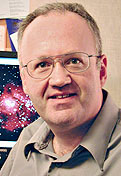








 I've already chronicled a few of my
I've already chronicled a few of my












